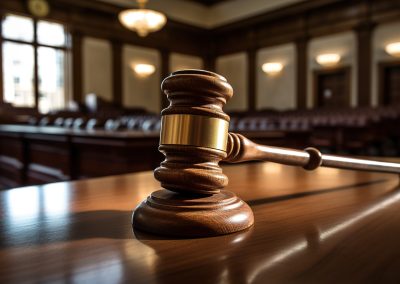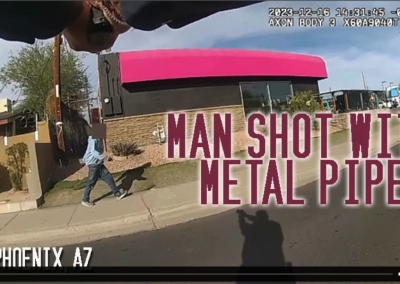In the spring of 2014 the highways around Kansas City were terrorized by an unknown shooter. Three people had been injured and more than ten vehicles had sustained bullet damage. There was very little information available until a woman called police and said she had been followed by a subject she thought might be the shooter. Because of his strange behavior, the woman noted his license plate number and vehicle description.
A check of the LPR database found records from more than a year prior where the plate had been displayed on two different vehicles. In one of those LPR captures, a vehicle similar to the one described by the witness was partially visible in the background. Later, the LPR system captured a record with the plate displayed on the reported suspicious vehicle. (It was apparent that the suspect was using the plate on different vehicles.)
Investigators learned that several months before the highway shootings began, a resident near the earlier LPR reads had reported finding a bullet hole in the wall of his home. That bullet was subsequently matched to rounds recovered in the highway shootings.
During the investigation of the shooting at the house, police had received a call from a subject who had found some empty ammunition boxes and shell casings after kicking a shopping bag he thought was empty. Police recovered the bag and lifted a fingerprint from it and from the flap of one of the ammo boxes. Both were determined to be from Mohammed Whitaker, 27, a subject who had connection to an address near the location of the earlier LPR reads.
Over a period of several days, investigators used cell phone pings, a warrant-authorized GPS tracker and intense surveillance to ultimately build their case against Mohammed Whitaker. He was taken into custody after being observed driving in a manner that suggested another shooting incident was imminent. The case demonstrated the critical role that technology, especially LPR, can play in police investigations.
We should also note: The relevant LPR reads in this case were captured several months before the shootings began.
Wavering Support
Although many departments initially embrace LPR technology to identify wanted vehicles, most soon realize there’s an even greater benefit when the captured data is used for investigative purposes. It’s this capability that has both “solved the unsolvable” and alarmed civil libertarians who see police use of LPR as an unwarranted and overly invasive monitoring of innocent citizens going about their daily lives.
This collision of public safety benefit and privacy concern is playing out across the country. Those who perceive LPR as an Orwellian instrument of the State have seized upon climate of the post-Snowden era and anti-police sentiment to convince anyone who will listen (including many legislators) that LPR use should be severely restricted. Their efforts have resulted in a significant erosion of capability. What was once vaunted as a force multiplier that would equal or surpass DNA in solving crimes is now being systematically dismantled.
Think that’s an overstatement? I know of specific cases in which departments have cancelled LPR equipment orders or downsized their programs. Many more have dialed back on the data retention period. Many states have enacted legislation that limits or restricts the use of LPR and imposed data retention periods that seriously limit crime analysis potential. I am personally aware of departments where existing equipment is being allowed to reach end-of-life and go dark because city council or county boards are reluctant to authorize funding for the now-controversial technology.
Make no mistake: LPR is definitely on the ropes.
Arguments for Opposition
Like many issues, it helps to understand the arguments being made by those who oppose law enforcement use of LPR.
Here’s a rather comprehensive statement from the 2013 ACLU publication You Are Being Tracked: “Longer retention periods and more widespread sharing allow law enforcement agents to assemble the individual puzzle pieces of where we have been over time into a single, high-resolution image of our lives. This constant monitoring and permanent recording violates our privacy in a number of respects.”
Most opponents acknowledge the benefit of using LPR to look for wanted cars, although they sometimes point to the large numbers of vehicles checked and note that only a small number of them result in police action.
Philadelphia PD recently released these figures for a period of approximately 18 months of LPR use: 29,785,983 plates were checked by LPR resulting in the recovery of 521 stolen autos, 106 terror suspect alerts and six criminal arrests. The response from Pennsylvania ACLU legal director Mary Catherine Roper was: “This is an extraordinary amount of government surveillance for what appears to be a very small amount of criminal activity.”
In fact, the figures from Philadelphia PD actually underscore the extreme effectiveness of LPR systems. The technology was able to scan millions of plates, something that hundreds of officers would have been unable to do, and to ferret out those vehicles needing further police attention, including those associated with potential terrorists. In other words, LPR technology allowed officers to take action in situations that would otherwise have been overlooked.
The ability to find the criminal equivalent of a needle in a haystack is a benefit to public safety, not an infringement on privacy. After the attacks of San Bernardino and the subsequent scramble to find the escape vehicle, I hope we can agree that facing the threats that today’s world presents will require technology to multiply our traditional p0licing capabilities.
Data Retention
It’s the retention of the data from the license plate scans that causes the most angst and the longer the data is held, the more strident the cries of protest.
There are two very different perspectives on this retained data. Law enforcement officials, especially those involved in crime analysis, see the data as a treasure trove of invaluable leads for solving crime series or placing a subject’s vehicle near the scene of a crime. (LPR has also provided exculpatory information when a vehicle could be shown to be away from where a crime occurred.) When it comes to retention, most law enforcement administrators feel strongly that longer is better and, until recently, many agencies kept data indefinitely.
Those who oppose the long-term retention of LPR data contend it should be kept for a very short time, certainly no more than month, and that keeping it longer simply gives police the power to “track” innocent citizens as they go about their daily lives and therefore violates their privacy.
There are significant problems with this statement. LPRs don’t track individuals. The word tracking implies a continual monitoring, and even cities with a robust LPR system are only capturing a small fraction of a vehicle’s travels. Those data captures are of license plates (not individuals), which are in public view as a vehicle is parked or operated in an area accessible to the public. And remember: License plates are the property of the issuing state and the law requires plates to be displayed for the world to see. In fact, every state feels so strongly about publicly displaying those plates that vehicles are required to have a light to illuminate the plate during nighttime operation.
A Case Overstated
In terms of potential abuse or misuse by public officials, LPR data is relatively innocuous when compared to the other types of data that officers have had access to for decades. A person’s home address, height and weight, date of birth, driving record, criminal record, and much more are all part of law enforcement databases that are queried daily without any outside questioning of their legitimacy. Most agencies have taken steps to ensure that their LPR systems have an audit trail and that policy (if not law) requires a legitimate reason for a query. In other words, steps have been taken to protect the data and minimize the potential for abuse.
Those who oppose LPR say the technology could be used to embarrass a person by exposing a vehicle frequenting a certain area thereby implying engagement in some type of embarrassing activity.
“If you had a corrupt mayor who could get access to this database, he could get information on his opponents,” said Electronic Frontier Foundation investigative researcher Dave Maass during an interview with the Louisiana-based newspaper, The Advocate. This is such a ridiculous argument that the rebuttal is self-evident. Any officer who engaged in this type of activity would be subject to discipline, dismissal and probably prosecution. The examples of this actually happening are non-existent.
Here are the basics that every department should already have in place: 1) Policy that specifies the purpose of the program and how the data is used; 2) a retention period that is supportive of the agency’s mission and in compliance with any applicable state law; 3) an LPR query system that has an audit trail which is randomly checked; and 4) appropriate training for operators of the equipment and database that includes clearly communicated consequences for inappropriate or unauthorized use. If you’re lacking in any of these areas, fix them before you create a problem for your program.
Conclusion
The recent terrorist attacks in France and San Bernardino provide a compelling reason for law enforcement to use LPR technology to its fullest. The very nature of terror operations means that there are networks of individuals who have to meet, perform reconnaissance of potential targets and transport weapons or munitions. Almost all of these involve the use of motor vehicles.
Shortly after the Paris bombings, authorities located a vehicle which had been involved in the attacks. Imagine the potential value of being able to determine where that vehicle had been and other vehicles or people that were associated with it. That information could be key to catching outstanding suspects (including the bomb maker) and preventing future attacks. This is the type of activity that our public wants us to protect them from and it’s absolutely imperative that we strive to keep our LPR systems operational and that the resulting data be available for legitimate law enforcement use. You can’t connect dots that you don’t have.
LPR technology has been responsible for solving many crimes, some of which would have gone unsolved but for the retained LPR data. It’s truly been a game changer for law enforcement and it has the potential to be a key factor in the fight against terrorism. Despite the value, the technology is currently under fire and its future is uncertain. It’s time for law enforcement to take proactive steps to help ensure this valuable technology doesn’t disappear from our crime-solving toolbox.
[Note: This is Part I of a two part series on LPR. The next installment will provide some specific steps you can take to mitigate public concern and outline an innovative approach to maximizing investigative benefit despite a shortened retention period.]










0 Comments